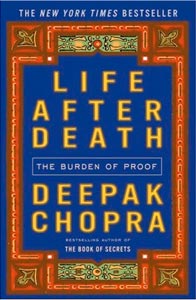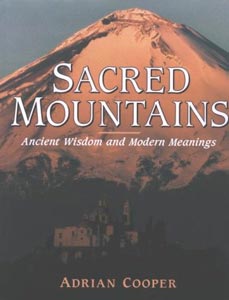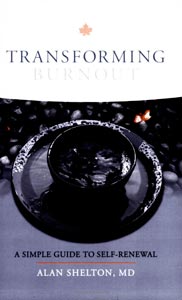 Life After Death: The Burden of Proof by Deepak Chopra, Harmony Books, New York, 2006; 304 pages, ISBN 0307345785, hardback, $24.00.
Life After Death: The Burden of Proof by Deepak Chopra, Harmony Books, New York, 2006; 304 pages, ISBN 0307345785, hardback, $24.00.
 Life After Death: The Burden of Proof by Deepak Chopra, Harmony Books, New York, 2006; 304 pages, ISBN 0307345785, hardback, $24.00.
Life After Death: The Burden of Proof by Deepak Chopra, Harmony Books, New York, 2006; 304 pages, ISBN 0307345785, hardback, $24.00.
Responding to our instinctive need to know what lies beyond death, Deepak Chopra brings together for our consideration the knowledge absorbed from his childhood, schooling, study of Eastern and Western religions and sciences, and his medical practice and experience in India and America. Using an allegorical tale recalled from his youth as a framework, he shares illuminating and helpful ideas about death and the hereafter that have enriched his life, teachings that he hopes will shed light into the darkness of ignorance. For instance, we are assured that death waits at the door of all sentient beings to take them into the light of a new life; that for the wise, death is simply letting the cloak which is our body fall to the floor; that death is birth into a fuller life; and that the miracle of creation lies in the fact that in every second of time life and death are joined in an eternal dance.
Pages are devoted to fascinating out-of-body and near-death experiences during which our consciousness, rising momentarily out of its body into astral realms, is able to see, hear, and understand what is happening around it. Also described are the panoramic reviews that often occur during such experiences. During such reviews people see the details of their past life with the “eyes of the soul” and understand not only the causes, purposes, and justice involved, but the resulting karma that awaits in the next incarnation. From The Tibetan Book of Living and Dying the author draws descriptions of the celestial “angels” and hellish “monsters” many people see when they die, explaining that such are the creations of our own thoughts and desires, loves and fears, during life. He also describes the levels of consciousness available for us when alive, levels referred to as lokas and talas in Hindu and theosophical writings. He also explains the various koshas or energy/substances which compose our natures, a teaching which augments the body/soul/spirit paradigm of Christian writers.
With this knowledge Deepak Chopra offers his readers the assurance that life is eternal, that death is but a doorway into higher realms of experience. To assist the reader he lists books for further study on these subjects, making Life After Death a remarkably informative and inspirational book. — Eloise Hart
 Sacred Mountains: Ancient Wisdom and Modern Meanings by Adrian Cooper, Floris Books, Edinburgh, 1997; 319 pages, ISBN 086315235, hardcover $49.95.
Sacred Mountains: Ancient Wisdom and Modern Meanings by Adrian Cooper, Floris Books, Edinburgh, 1997; 319 pages, ISBN 086315235, hardcover $49.95.
Adrian Cooper’s interviews with 144 pilgrims of many faiths from all over the world have one thing in common: a fascination with the inspirational quality of mountains. These people each had their own reasons for traveling to their chosen mountain destinations. Through his interviews with these spiritual seekers, Cooper explores how their truths were first encountered, how they challenged the pilgrims, and how those individuals changed, not only in the mountains but also when they returned home.
Sacred Mountains took thirteen years of patient research to compile, and every contributor was interviewed over a period of years. Extracts from interviews let us read first hand what it feels like when mountains bring profound change and renewal. Another fundamental element is Cooper’s extracts from sacred texts, poems, and inspirational books which influenced each pilgrim, and what a range of books there are! From the Bhagavad Gita, Upanishads, Torah, New Testament, Eddas, Manyoshu, Iliad, and Metamorphoses to the works of Muir, Thoreau, and modern authors, the list is long and fascinating.
But who are these pilgrims Adrian Cooper spent so much time with — famous spiritual authors or other media personalities? No, they are ordinary people like you and me: car mechanics and office workers, business people and teachers, single parents, hairdressers, artists, electricians, musicians, truck drivers, and students. The author shows convincingly that the power of mountain sacredness is available to all if only we would be humble enough to let it in. Nor are sacred mountains restricted to the distant realms of history and myth; they can be alive for all of us today. — Toni Fergusson
Illuminating the Path to Enlightenment by H. H. Dalai Lama, Lama Yeshe Wisdom Archive, Weston, MA, 2002; ISBN 0962342165, 186 pages, paperback, free distribution.
For those with an affinity for the Eastern classics, this commentary by the Dalai Lama on Atisha’s A Lamp for the Path to Enlightenment and Tsong Khapa’s Lines of Experience revisits the bodhisattva path of compassion with lucid explanation for altruism in thought and practice. The Dalai Lama approaches these works, both presented in full, with gentle encouragement for study, analysis, reasoning, and debate, to realize what is true in life and to influence harmonious living. The chapter on “The Perfection of Wisdom” gives us the opportunity to discover Buddhism purified in the four seals: 1) All composite phenomena are impermanent; 2) All contaminated phenomena are unsatisfactory, or in the nature of suffering; 3) All things or events are empty or devoid of self-existence; and 4) Nirvana is true peace. Capturing a glimpse of these four tenets returns us to the perennial philosophy with veneration for the teacher, appreciation for the teachings and the circumstances that allowed us to know them, and also in fellowship with those who share the path. This book recharges the goal of altruism. — Robert Patton
 Transforming Burnout: A Simple Guide to Self-Renewal by Alan Shelton, Vibrant Press, Tacoma, WA, 2007; ISBN 0978795202, 82 pages, paperback, $12.95.
Transforming Burnout: A Simple Guide to Self-Renewal by Alan Shelton, Vibrant Press, Tacoma, WA, 2007; ISBN 0978795202, 82 pages, paperback, $12.95.
This book provides practical advice for those who find themselves faced with a severe loss of enthusiasm and energy at work. The author tells of his own struggle with burnout after twenty years as a physician for the Puyallup Tribal Health Authority, and how concepts such as the Native American Wellness Circle helped him reconnect with his spiritual life. He defines spirituality as “our true essence. It is that part of our life which relates to our soul, which from a spiritual perspective is connected to the Divine and is infinite. This lifetime is but the physical experience of our deeper reality, our spirit, which is our fundamental nature” (p. 28). He goes on to explain that “Spirituality involves a reverent attitude toward all things because it awakens us to a divine presence in all things. In this way of seeing and being, all things and persons are interconnected and interdependent. The spiritual world is the unseen world, and thus wrapped in mystery. . . . Yet this spirit, full of mystery, is every bit as real as the visible, tangible world” (p. 26).
After discussing what burnout, wellness, and spirituality are, Dr. Shelton shares ways in which people can foster this often-neglected aspect of themselves. Such ongoing attention to our inner selves overcomes burnout because “When our spirituality is nurtured and vibrant, we’re ‘connected.’ This connection is a sense of relationship to the Creator, Great Spirit, or God (Divine Force), as well as a relationship to all people and to Mother Earth (our life-giving environment). Spirituality takes us beyond our ego-centered lives by expanding our hearts with compassion toward all” (pp. 25-6). Its simple, direct, informal style and undogmatic presentation make this a particularly helpful book. — Sarah Belle Dougherty
(From Sunrise magazine, Fall 2007; copyright © 2007 Theosophical University Press)